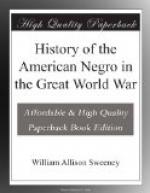The trip home in February, 1919, was about as perilous to some of them as the war had been. It was a period of unusually rough weather. The north Atlantic, never very smooth during the winter months, put on some extra touches for the returning Negro soldiers. An experience common to many on several different transports has been described by Mechanic Charles E. Bryan of Battery B, 351st Artillery upon his return to his home, 5658 Frankstown Avenue, Pittsburgh, Pa. Asked about his impressions of the war, he said that which impressed him the most was the storm at sea on the way home.
“That storm beat the war all hollow,” he said. “Me and my buddies were messing when the ship turned about eighteen somersaults, and we all pitched on the floor, spilling soup and beans and things all over the ship.
“The lights went out and somehow the automatic bell which means ’abandon ship’ was rung by accident. We didn’t know it was an accident, and from the way the ship pitched we thought she was on her way down to look up one Mr. Davy Jones. So we made a break for the decks, and believe me, some of those lads who had come through battles and all sorts of dangers were about to take a dive over the side if our officers had not started explaining in time.”
Stories of varying degrees of interest, some thrilling, some humorous and some pathetic to the last degree, have been brought back.
Ralph Tyler, the Negro newspaper man, who was sent to France as the official representative of the Afro-American press by the Committee on Public Information, has written many of the incidents, and told others from the rostrum. He has told how the small insignificant, crowded freight cars in which the soldiers traveled looked like Pullman parlor coaches to the Negro soldiers.
“To many of our people back in the ‘States,’” wrote Mr. Tyler from France, “who saw our boys embark on fine American railroad coaches and Pullman sleepers to cover the first lap of their hoped-for pilgrimage to Berlin, the coaches they must ride in over here would arouse a mild protest. I stood at Vierzon, one of France’s many quaint old towns recently, and saw a long train of freight cars roll in, en route to some point further distant. In these cars with but a limited number of boxes to sit upon, and just the floors to stand upon, were crowded some 1,000 of our own colored soldiers from the States. But a jollier crowd never rode through American cities in Pullman sleepers and diners than those 1,000 colored troopers. They accepted passage on these rude box freight cars cheerfully, for they knew they were now in war, and palace cars, downy coaches and the usual American railroad conveniences were neither available nor desirable.
“The point I wish to convey to the people back home is that did they but know how cheerfully, even eagerly our boys over here accept war time conveniences, they would not worry quite so




